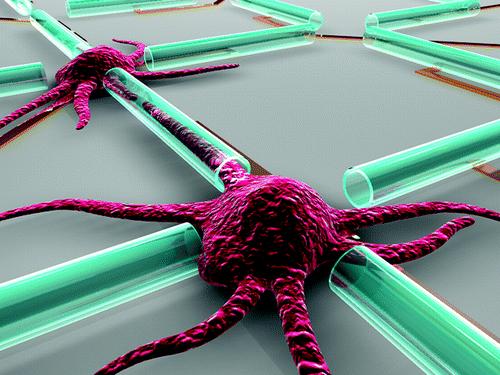Neurons grow into semiconductor tubes: future intelligent chips?
March 23, 2011

Neural cells are seeded at the intersection of four tubes whose diameter is close to that of a single axon. The tube topography can attract the outgrowth of neural processes (neurites) and eventually guide them into defined neural networks. (Image credit: University of Wisconsin - Madison)
Researchers at the University of Wisconsin, Madison, led by Minrui Yu, have successfully induced nerve cell tendrils to grow through semiconductor tubes using strained silicon (Si) and germanium (Ge) nanomembranes as a cell culture substrate.
In many neural culture studies, neurite migration on a flat, open surface does not reflect the three-dimensional (3D) microenvironment in vivo.
Their xperiments show that the SiGe substrate and the tube fabrication process are biologically viable for neuron cells. They also observed that neurons are attracted by the tube topography, even in the absence of adhesion factors. They can be guided to pass through the tubes during outgrowth, leading to defined neuronal networks. Coupled with selective seeding of individual neurons close to the tube opening, growth within a tube can be limited to a single axon.
The tubes also resemble natural myelin, both physically and electrically, and it is possible to control the tube diameter to be close to that of an axon, providing a confined 3D contact with the axon membrane and potentially insulating it from the extracellular solution.
Aside from being 3D morphological cues for cell growth, the thin-walled tubes are transparent and light can be used to stimulate genetically expressed light-sensitive neurites inside. Electrodes can then pick up the corresponding neural signals.
Ref.: “Semiconductor Nanomembrane Tubes: Three-Dimensional Confinement for Controlled Neurite Outgrowth,” ACS Nano, March 2, 2011.